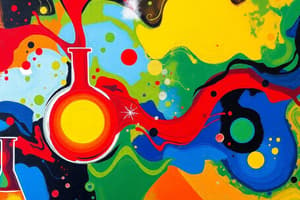Podcast
Questions and Answers
What does a positive change in enthalpy (ΔH) indicate about a reaction?
What does a positive change in enthalpy (ΔH) indicate about a reaction?
- The products have less energy than the reactants.
- Energy is released during the reaction.
- The reaction is at equilibrium.
- Energy is absorbed during the reaction. (correct)
In an exothermic reaction, what happens to the temperature of the surroundings?
In an exothermic reaction, what happens to the temperature of the surroundings?
- The temperature increases. (correct)
- The temperature decreases.
- The reaction feels neutral.
- The temperature stays the same.
What does the activation energy represent in a chemical reaction?
What does the activation energy represent in a chemical reaction?
- The energy required to maintain equilibrium.
- The total energy of the products.
- The energy released by an exothermic reaction.
- The minimum energy needed for colliding particles to react. (correct)
Which statement is true regarding an endothermic reaction?
Which statement is true regarding an endothermic reaction?
What role does a catalyst play in a chemical reaction?
What role does a catalyst play in a chemical reaction?
During a reaction that produces water from hydrogen and oxygen, which statement is correct?
During a reaction that produces water from hydrogen and oxygen, which statement is correct?
What can be inferred about the products in an endothermic reaction compared to the reactants?
What can be inferred about the products in an endothermic reaction compared to the reactants?
Which of the following is true about the heat of reaction (ΔH) for an exothermic process?
Which of the following is true about the heat of reaction (ΔH) for an exothermic process?
Flashcards are hidden until you start studying
Study Notes
Enthalpy
- Enthalpy (H) is the measure of heat energy.
- Change in enthalpy (ΔH) reflects energy required or released during a reaction.
- ΔH = Hproducts – Hreactants
- Positive ΔH means energy is absorbed (endothermic).
- Negative ΔH means energy is released (exothermic).
Endothermic Reaction
- Heat (energy) is absorbed.
- Feels cold and temperature decreases.
- Products have more energy than reactants.
- ΔH is positive.
Exothermic Reaction
- Heat (energy) is released.
- Feels hot and temperature increases.
- Reactants have more energy than products.
- ΔH is negative.
Collision Theory
- Atoms, ions, or molecules react to form products when they collide, IF, they have enough energy.
- This energy is called Activation Energy.
- The minimum energy colliding particles need to have to react.
- For example, the reaction between hydrogen and oxygen to form water: 2H2 + O2 🡪 2H2O
Activated Complex
- An unstable arrangement of atoms that forms momentarily at the activation-energy barrier.
- Also known as the transition state.
Endothermic or Exothermic
- The energy of products is higher than reactants in an endothermic reaction.
- The Heat of Reaction (ΔH) is positive for endothermic reactions.
- The energy of products is lower than reactants in an exothermic reaction.
- The Heat of Reaction (ΔH) is negative for exothermic reactions.
Catalyst
- A catalyst increases the rate of reaction by lowering the activation-energy barrier.
- A catalyst does not affect the Heat of Reaction.
Studying That Suits You
Use AI to generate personalized quizzes and flashcards to suit your learning preferences.




